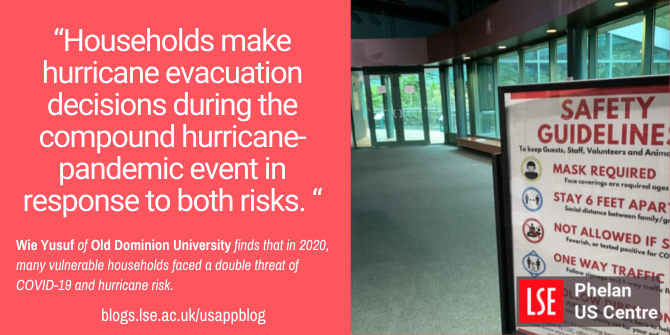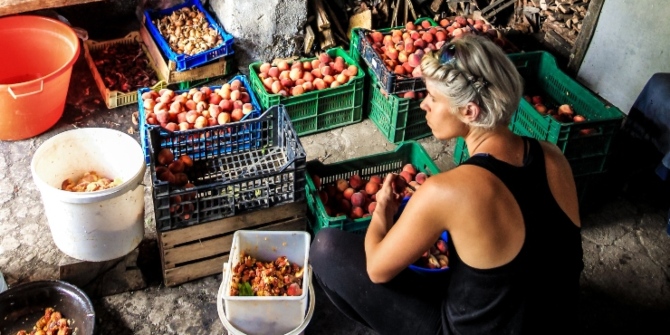 The COVID-19 pandemic did not occur in isolation, with many households also facing threats from natural disasters such as hurricanes. The need to evacuate in the face of hurricane threat was complicated by COVID-19 mitigation measures such as social distancing. In new research, Wie Yusuf looks at the behavior of households in the community of Hampton Roads, Virginia. She finds that households vulnerable to hurricane risks were also at higher risk of virus infection and that households with lower incomes and that identified as racial minorities had fewer available resources to evacuate out of the region.
The COVID-19 pandemic did not occur in isolation, with many households also facing threats from natural disasters such as hurricanes. The need to evacuate in the face of hurricane threat was complicated by COVID-19 mitigation measures such as social distancing. In new research, Wie Yusuf looks at the behavior of households in the community of Hampton Roads, Virginia. She finds that households vulnerable to hurricane risks were also at higher risk of virus infection and that households with lower incomes and that identified as racial minorities had fewer available resources to evacuate out of the region.
About 95 million people live in communities on the US coasts, and an estimated 60 million in areas at highest risk of hurricanes. However, other hazards occur throughout the hurricane season, leading to overlapping or compound threats that complicate how communities respond to hurricanes. The compound threat of hurricanes during the COVID-19 pandemic offered insights into how households responded to both the hurricane and virus threats.
In research conducted during the pre-vaccine period of the COVID-19 pandemic, we examined the evacuation behavior of households facing a compound hurricane-pandemic threat and how factors associated with the COVID-19 pandemic and a hurricane influence evacuation behaviors of households. Under this compound threat, households must consider different risks depending on various dimensions of vulnerability associated with the threats and impacts of the hurricane and COVID-19 infection, and resulting from factors such as medical fragility and resource limitations that pose barriers to evacuation.
Hurricane evacuation and the added challenge of the COVID-19 pandemic
During a compound hurricane-pandemic event, evacuation and mass sheltering, where people travel or congregate together in close proximity for long periods, were at odds with virus containment strategies such as social distancing, self-isolation, and quarantining. The COVID-19 pandemic required adjustment to household’s hurricane response strategies as households might need to make trade-offs between the risk reduction strategies for a hurricane versus the pandemic.
Households living in high-risk areas subject to storm surge, flooding, and strong winds are physically vulnerable to hurricane impacts and more likely to evacuate. Being closer to high-risk areas for COVID-19 infection decreases the household’s likelihood of evacuation. The concept of social propinquity – the idea that people tend to form bonds with people they associate with more often – measures COVID-19 vulnerability from a social network perspective where households whose social networks include others who have been exposed to or died from COVID-19 (i.e., have higher social propinquity to COVID-19) have greater exposure to and risk of infection. As connections to other households and networks who were exposed to COVID-19 and the perceived risk of the virus increased, households may be less concerned about hurricane risk reduction compared to reducing potential for infection.

“Virginia Living Museum amid COVID-19 [Image 2 of 2], by Max Lonzanida” via DVIDS. The appearance of U.S. Department of Defense (DoD) visual information does not imply or constitute DoD endorsement.
In addition to vulnerabilities specific to hurricanes or the pandemic, households are vulnerable to factors that impede evacuation due to both hazards. Some households may not evacuate due to barriers such as resource constraints, fear of disruption to medical care, or physical mobility concerns. As such, as Figure 1 illustrates, the factors that lead to evacuation decisions of households during a compound hurricane-pandemic are intertwined with pre-existing health and socio-economic inequities that may increase vulnerability.
Figure 1 – Conceptual framework of hurricane evacuation, vulnerabilities, impediments, and equity impacts of socio-economic characteristics

Household evacuations in Hampton Roads in coastal Virginia
We examined the factors contributing to household evacuation during a compound hurricane-pandemic threat using data from a random, stratified survey of households in Hampton Roads, Virginia, conducted during the 2020 Atlantic hurricane season. Households were asked about whether they would evacuate if facing a significant hurricane during the 2020 hurricane season and the COVID-19 pandemic. Of the 2155 who responded to the survey, 49 percent planned to evacuate outside the region and 51 percent planned to stay.
Our results show that households make hurricane evacuation decisions during the compound hurricane-pandemic event in response to both risks. Households in areas vulnerable to storm surge and flooding were more likely to evacuate. Households with greater COVID-19 social propinquity were also more likely to evacuate out of the region. In the specific case of the two hazards, there was overlap between hurricane and pandemic vulnerabilities. Households vulnerable to hurricane risks were also at higher risk of virus infection.
Not surprisingly, having sufficient resources to evacuate contributed to households’ deciding to evacuate. However, the resources available to households to support their evacuation were also affected by hurricane and pandemic risks. Households whose resource bases were vulnerable to storm-caused wage losses, such as those reliant on income from the hospitality or tourism sectors, were more likely to evacuate. Negative impacts of the pandemic on the household’s resource base, on the other hand, did not contribute to evacuation behavior. Medical fragility was also not an obstacle to household evacuation behavior.
Equity implications
Disproportionate vulnerabilities experienced by socially marginalized groups make it challenging for these households to evacuate, while continued social injustices and inequalities amplify pandemic impacts. Our analysis specifically focused on the vulnerabilities of under-resourced and minority groups, recognizing that their disparate abilities to act can have equity implications for policies and practices to support evacuation and sheltering during a compound hurricane-pandemic event.
Household income and race contributed to vulnerability to the pandemic and factored heavily in terms of resource-related impediments to evacuation. Higher income households were more likely to have the financial resources needed to evacuate and less likely to suffer negative financial impacts of a hurricane or pandemic.
Households identifying as racial minorities had fewer resources to evacuate and experienced decreased wages or income due to the pandemic or hurricane. These point to equity concerns as lower-income households and racial minorities are disproportionately vulnerable to pandemic impacts and experience disproportionate resource impacts. These create disparities in their ability to evacuate and feed into their hurricane evacuation decisions.
- This article is based on the paper “Evacuation behavior of households facing compound hurricane-pandemic threats” published in Public Administration Review.
- Please read our comments policy before commenting.
- Note: This article gives the views of the author, and not the position of USAPP – American Politics and Policy, nor the London School of Economics.
- Shortened URL for this post: https://bit.ly/49pB5xK






